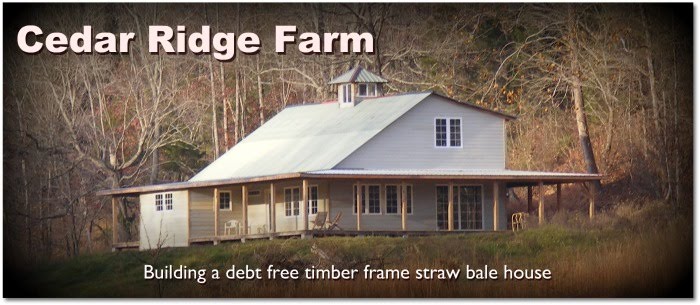On Thursday of last week (7/12/07), I was able to fit up the back wall of the frame. Mark the Intern helped. This involved fitting together 4 posts, 6 girts, and 6 braces and drilling the holes for the pegs. It went together quite well. However, I forgot to take the camera, so no pictures. It looked a lot like the pictures from earlier, though. It's really neat to see what I've been working on for over two years actually begin to take shape.
I'm contemplating raising the frame. Basically, I'm trying to get it straight in my head how it'll be done. I'm not planning on renting a crane to do the job. Yeah, a crane would probably make things easier, but it would also create its own challenges. I think that with enough help and a gin pole, we can get the job done safely and relatively easily. I've never done this before, so I might be wrong.

One of my intentions at this point is to raise each bent completely finished, including the rafters. Because of the design of the bent, the weakest point will be where the rafter and two posts attach to the tie beam. The only thing holding them will be 2"x4" mortise/tenon joints. My idea is to securely clamp three 6"x6"s or 6"x8"s on the back of the bent. These will be long enough to be attached to the lower beams, the tie beam, and the rafters. Then, when raising the bent, I will pull on these braces, not the bent itself. They will hold the bent rigid while they take the stress of the raising.

The gin pole I have in mind is what is called a pair of 'shear legs.' It's basically an A-frame of two poles. I 'borrowed' the picture at the right from
The Mountain School. I'll probably use a couple of cedar trees since I have a lot of those here, and they'll be relatively straight and long enough. Long enough for my uses will be 25-30 feet. I won't have to lift more than 22 feet. The shear legs feet are securely anchored so they won't move. I'll probably set them in a couple of holes and chain them to a couple of my foundation piers. It'll also be secured by lines to anchors or trees toward the back. In barn raising from this photo, they used a block and tackle rigging and raised their bents with human power. I'm planning on using a tractor to supply the power to raise the bents.
I'll continue pondering on the raising. I want it to go well, smoothly, and relatively quickly. It'll be an exciting day, I'm sure. I don't know when it'll be yet, but I'll be sure to announce it and invite lots of help!
 One of my intentions at this point is to raise each bent completely finished, including the rafters. Because of the design of the bent, the weakest point will be where the rafter and two posts attach to the tie beam. The only thing holding them will be 2"x4" mortise/tenon joints. My idea is to securely clamp three 6"x6"s or 6"x8"s on the back of the bent. These will be long enough to be attached to the lower beams, the tie beam, and the rafters. Then, when raising the bent, I will pull on these braces, not the bent itself. They will hold the bent rigid while they take the stress of the raising.
One of my intentions at this point is to raise each bent completely finished, including the rafters. Because of the design of the bent, the weakest point will be where the rafter and two posts attach to the tie beam. The only thing holding them will be 2"x4" mortise/tenon joints. My idea is to securely clamp three 6"x6"s or 6"x8"s on the back of the bent. These will be long enough to be attached to the lower beams, the tie beam, and the rafters. Then, when raising the bent, I will pull on these braces, not the bent itself. They will hold the bent rigid while they take the stress of the raising.
1 comment:
When we raised our frame, we used an A frame as you plan to and a winch that was mounted onto a 4WD. This gave a really steady raise.
Post a Comment